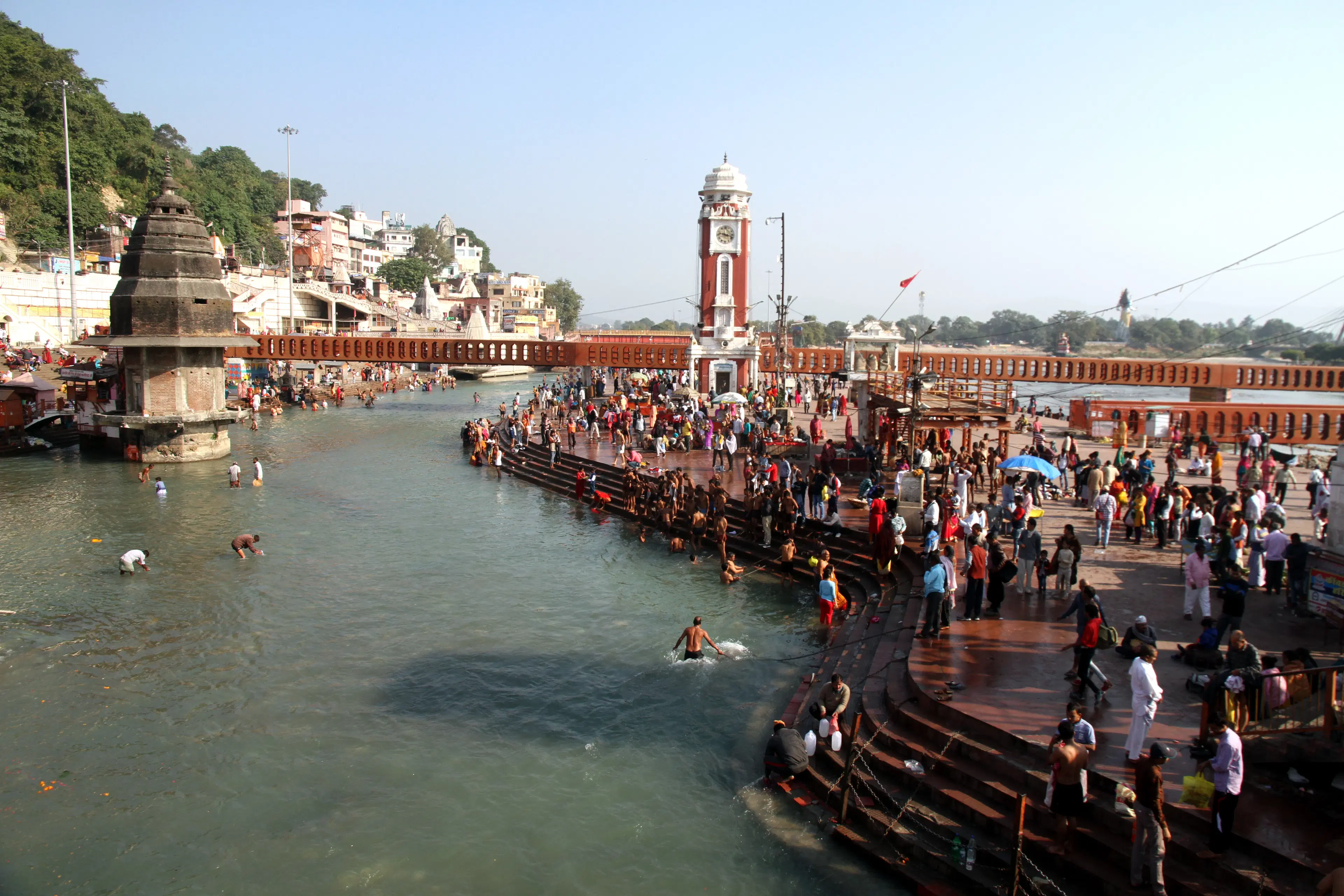
Flights
•04 min read

Imagine standing at the edge of an ancient river, where the soft murmur of the water mingles with the resonant chants of devotees. India's historic ghats are more than just stepped riverfronts. They are sacred sanctuaries where tradition and spirituality converge in timeless rituals. Journey with us as we explore seven iconic ghats, each breathing the spirit of centuries-old traditions and offering a portal into the heart of India's cultural heritage.
Ghats are ancient riverfront steps that descend gracefully to sacred rivers. They have served as pilgrimage sites for centuries, hosting traditional ceremonies at ghats and acting as a rendezvous of cultural and spiritual practices. These ancient riverfront sites are not mere physical structures but living testimonies to India's vibrant rituals and customs.
Rituals performed at these sacred ghats connect individuals with divine energies. Whether it’s through the purification of the soul, cremation rites that honor the cyclical nature of life, or prayer ceremonies that echo through time, the spiritual rituals by the river serve as a reminder of the deep-rooted religious practices that have become synonymous with these cultural heritage ghats.
Located in the ancient city of Varanasi, Dashashwamedh Ghat is steeped in history and legend. Traditionally associated with Lord Brahma, this ghat has for centuries drawn pilgrims and travelers alike. The ghat is most renowned for its mesmerizing Ganga Aarti, where the setting sun and the flickering lamps create an enchanting atmosphere that captivates every onlooker.
At Dashashwamedh, visitors can witness the intimate rituals that involve offering prayers to the Ganges. As dusk blends into night, the evening aarti transforms the ghat into a spectacle of devotion, marked by fire, incense, and mellifluous hymns that have been echoed across the ages. These ceremonies underscore the ghat’s status as one of the ultimate pilgrimage sites with rituals.
Manikarnika Ghat, one of the oldest in Varanasi, is intimately linked with the concept of moksha, or liberation. Known as a powerful site for the last rites, it is believed that the soul liberated here escapes the endless cycle of rebirth. The ghat’s significance is heightened by its role in traditional cremation ceremonies that are integral to Hindu spiritual beliefs.

The rituals at Manikarnika are profound and deeply ceremonial. The process of cremation here is not only an end but also a passage to eternal life. A central element of these rites is the eternal flame that burns continuously, symbolizing the perpetual cycle of life and liberation. This sacred fire is regarded as a beacon of spiritual freedom, illuminating the path to moksha.
For those seeking a quieter, more reflective experience, Assi Ghat offers a serene retreat on the bustling banks of the Ganges. Revered for its calm ambiance, this ghat is a favorite among locals and travelers yearning for meditation and peaceful contemplation. Its connection to Shiva, revered by many, adds an extra layer of spiritual depth to the experience.
Morning at Assi Ghat is a time for rejuvenation. As the sun rises, groups engage in yoga sessions and partake in meditation, making use of the natural setting to align their energies. Traditional ceremonies and sacred riverbank rituals are part of the daily routine, inviting visitors to experience the slow, reflective pace of life along these historic waterfront traditions.
Har Ki Pauri in Haridwar is celebrated for its role in the grand Kumbh Mela and is renowned for its sacred riverbank rituals. Each evening, the aarti performed here transforms the ghat into a glowing, ethereal space, making it one of the most spiritually charged pilgrimage sites with rituals.
Sangam Ghat is unique because it is located at the confluence of three sacred rivers. This merging point is imbued with a magnetic spirituality that draws millions during the Magh Mela. The ritual of bathing here, a symbolic purification, underscores the ghat's significance in the panorama of religious practices at ghats.
Named after the revered poet Tulsidas, Tulsi Ghat has a quaint charm enriched by its literary and historical significance. Here, ancient rituals blend with cultural narratives, offering visitors a glimpse into the artistic soul of Varanasi. The spiritual rituals by the river performed here often involve poetic recitations and devotional songs, making it a serene yet engaging stop.

Despite their rich heritage, these iconic ghats face modern challenges. Pollution and overcrowding threaten their sanctity and beauty. Preservation efforts are crucial in maintaining the integrity of these sacred sites, ensuring that the traditional ceremonies at ghats continue to inspire future generations.
Every visitor plays a role in preserving these historic ghats with rituals. Practicing responsible tourism by respecting the rituals and minimizing environmental impact is essential. Visitors are encouraged to immerse themselves in the spiritual essence of these sites, while remaining mindful of the delicate balance between tradition and modernity.
Did you know? The eternal flame at Manikarnika Ghat has been burning for centuries, symbolizing the cycle of life and liberation. It is believed that those cremated here achieve moksha, freeing them from the cycle of rebirth.
Dashashwamedh Ghat in Varanasi is considered the holiest due to its association with Lord Brahma and its iconic Ganga Aarti ceremony.
Rituals include cremation at ghats like Manikarnika, offerings to the river, and prayers for the departed soul's liberation.
The Ganga Aarti at Dashashwamedh Ghat is one of the most famous rituals in Varanasi, symbolizing devotion and gratitude to the Ganges River.
The exploration of historic ghats with rituals offers a profound insight into India's cultural tapestry. These sacred riverbank rituals and traditional ceremonies at ghats not only illuminate ancient spiritual practices but also ensure that the legacy of these historic waterfront traditions endures. Embracing the majestic blend of history, spirituality, and culture at these ghats deepens our understanding of the eternal dance between life and liberation.